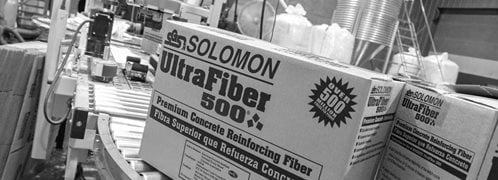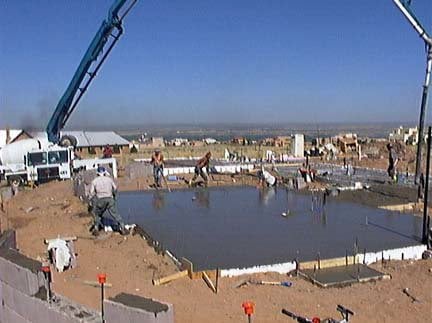- Concrete slabs home
- Use a low water-cement ratio: How to calculate
- Subgrades and subbases for concrete slabs: Tips for ensuring good support
- Concrete Slab Finishing Tips
- DIY Slab Mistakes to Avoid
- How to Prevent Cracks
- Guidelines for preventing cracks in concrete slabs
- Be active in deciding where control joints will be placed
- Reinforcing Concrete Slabs
- Proper Curing of Concrete Slabs
- Properly curing concrete slabs: Why and how
- Related Information:
- Concrete fasteners
- Concrete forms
- The three types of concrete foundations
- Aggregates in ready-mix concrete
- Vapor barriers for concrete slabs
- Post-tensioned concrete slabs
- Concrete slabjacking
- Concrete testing
Concrete Slab Construction - Building High Quality Slabs
A primer on how to make a concrete slab that will lastConcrete slabs are used to support everything from patio furniture, to foot traffic, to semi-trailer trucks. With such a wide range of purposes and support requirements, concrete slabs present many construction variables that must be considered before concrete placement begins.
A slab pour requires efficient planning so that all of the elements that go into producing a high-quality slab are done in time (before the concrete sets) and done correctly. Knowing the right finishing tools to use and the right time to start bull floating and final troweling are essential to preventing dusting, scaling and craze cracking of the slab.
You also need to provide a firm and stable base for the concrete slab by compacting the subgrade properly. Neglecting this critical step can result in serious slab settlement and cracking problems, especially in slabs placed on poor subsoil or exposed to heavy traffic conditions.
Determining the right concrete mix design and reinforcement requirements for the anticipated slab exposure and traffic conditions is essential as well. You’ll need to calculate the proper water-cement ratio and air-entrainment requirements for the concrete mix to ensure that the slab will perform as intended. Proper positioning and support of wire reinforcement is also important to control and minimize cracking.
After concrete placement, you have a whole new set of issues to address, such as proper placement and spacing of control joints and adequate curing. The timing and execution of these post-pour activities are equally essential to good slab performance, since rapid drying of a slab and improper installation of control joints can lead to inadequate strength and unwanted cracking. Concrete that is moist cured for at least seven days is about 50% stronger than uncured concrete.
The information in this section will guide you through the steps required to build high-quality concrete slabs on grade and help you avoid mistakes that can lead to poor performance, or even worse, slab failure. You’ll also find advice on concrete mix design and calculating the water-cement ratio.
BUILD A HIGH QUALITY SLAB ON GRADE
Why build a high quality slab on grade is best answered with, "what happens when you don't!"
If the concrete is out of level (greater than ¼" in 10') it causes expensive shimming or cutting of framing. If corrections are not made during framing lid lines (where the wall meets the ceiling) may be noticeably out of level.
If the water cement ratio is above .50 the concrete can be overly permeable causing adhesives for vinyl flooring to loosen, mold or mildew to form under vinyl, vinyl to yellow, and grout in tile to become wet. Excessive cracking can cause further problems with flooring materials and water permeation through the slab. Learn more about using a low water to cement ratio.
If air entrainment is not used in the mix in cold weather climates, water inside the concrete can expand when freezing temperatures hit and fracture the concrete.
If control joints are not used with the proper spacing and placement unsightly cracks can develop, telegraphing through vinyl or breaking tile grout. Learn more about control joint placement.
If wire mesh is used in the slab but blocks to support the mesh are not used the mesh can end up on the ground-not in the concrete, thus cracks that develop may widen causing problems with flooring or water permeability. Consider fibers in the concrete mix instead.
If the subgrade is not compacted and the ground becomes saturated after a good rain, the plumbing trenches under the house may collapse or the utility trenches connecting to the street may collapse under the driveway or other concrete flatwork-leaving no support for the concrete.
If the concrete is not properly cured the concrete may develop cracks that would not otherwise have occurred. Proper curing delays the drying shrinkage until the concrete is strong enough to resist shrinkage cracking. Concrete which is moist cured for 7 days is about 50% stronger than concrete exposed to dry air for the same period.
DECORATIVE CONCRETE FLATWORK
Take special pride in the flatwork around your home. The driveways, walkways, and patios around your home will be exposed for the world to see.
Review the Decorative Concrete section and consider how an exposed aggregate finish, or colored concrete, or one of the other choices in that section can match the stone or other exterior treatment your home has.
If you do choose decorative concrete, or go with plain concrete for your flatwork, follow the steps in building high quality concrete slabs and you will be pleased with the results.
 Brickform Ultra-M1x
Add color and fiber with one product
Brickform Ultra-M1x
Add color and fiber with one product
 Rescue-Pak
Contains six of the most effective admixtures
Rescue-Pak
Contains six of the most effective admixtures
 UltraFiber 500®
Will not ball or fuzz, accepts color
UltraFiber 500®
Will not ball or fuzz, accepts color








